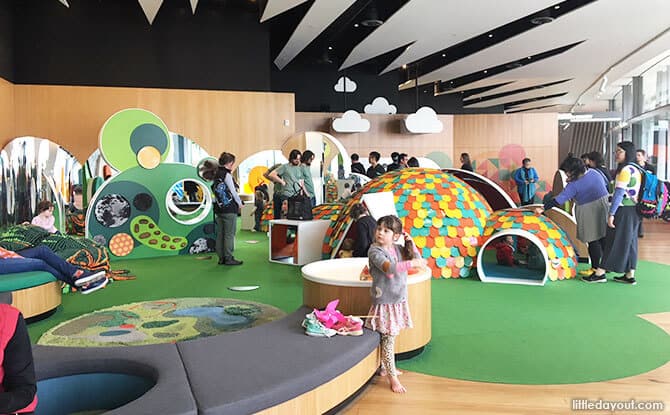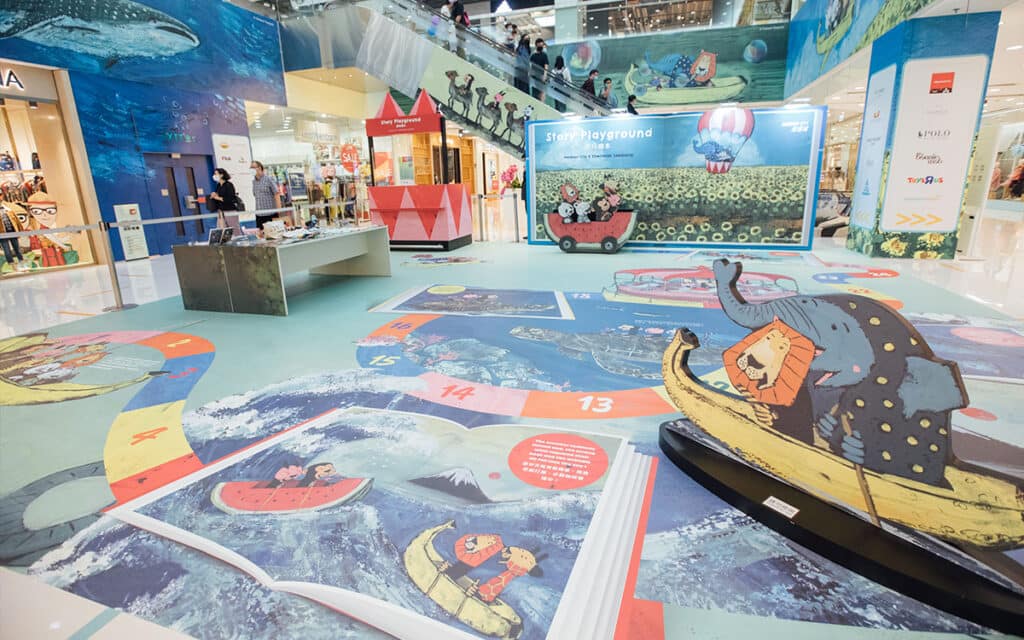Indoor playgrounds have become a staple in many urban areas, offering children a safe and exciting place to play regardless of the weather outside.
But what goes into designing these spaces? How can we ensure they’re both fun and meaningful while also being immersive? Let’s delve into indoor playground design and its many facets.
Types of Indoor Playgrounds: Beyond the Basics
When we think of an indoor playground, several types might come to mind:
- Mall Play Areas: Often found in shopping centres, these are small zones where kids can play while parents shop. They’re usually free and offer basic play structures.
However, with a better understanding of play value and its benefits to children, malls are investing more in these playgrounds as an attraction, setting themselves apart to attract more customers and families. - Indoor Play Spaces: These larger, dedicated areas are often filled with ball pits, slides, and climbing structures. While there might be an entry fee, they offer more extensive play options.
These spaces are particularly popular during holiday periods, so the design challenge is keeping them engaging year-round. - Indoor Adventure Playgrounds: Think of these as mini theme parks. They often have themed zones, interactive games, and even tech-driven attractions. Focusing on different levels and challenges, this type of playground can convey a local story while also being enjoyable for its users.
They also introduce the concept of risky play, which is crucial for children’s developmental play. - Interactive Museums: These are spaces where play meets education. Children can learn while they play, often through hands-on exhibits.
An indoor playground at a museum can effectively introduce concepts to younger children who might not grasp some of the more complex museum features.

Local Storytelling: Making Play Meaningful
Every location has a tale to tell. Whether it’s about the history of the city, local legends, or cultural stories, integrating these narratives into the playground design can enrich the experience.
In an indoor playground setting, you can control the whole environment and tell stories better and with more detail.
For example, New Zealand could tell the story of the local Iwi or trace the country’s history. Such spaces can recount tales of wildlife, bridging past and present playfully.

Immersive Play: Elevating the Fun
Today’s kids are tech-savvy. By incorporating technology – projections, interactive touchpoints, augmented reality – we can offer a genuinely immersive play experience.
This type of technology for indoor playgrounds enable a better in-depth experience and exploration of fun for children. The idea of bringing spaces to life with immersive fun that can be hidden or fully integrated in their experience.
Designing with Purpose: Who's the Target Audience?
Successful indoor playground design hinges on understanding its users. Is the playground for toddlers, older children, or both? It should allow effortless movement, ensuring children can navigate freely and safely.
Different zones for varying age groups cater to diverse play needs. Other factors, like the playground’s proximity to food amenities and the available area, are crucial considerations.
Essential Equipment for Indoor Playgrounds
A well-designed indoor playground isn’t just about the space but also the equipment within. Ensuring a mix of activities and structures tailored to various age groups and abilities can make a difference in the playground’s appeal.
Here’s a look at some popular equipment types:
- Slides: A playground staple, slides come in various sizes and designs, from simple straight designs to twisty and tunnel variants.
- Climbing Walls: These offer both fun and a physical challenge. Walls can be designed with varying difficulty levels to cater to different age groups and abilities.
- Ball Pits: Another favourite, ball pits can be a sensory delight for children. Ensure that the balls and pit are regularly cleaned to maintain hygiene.
- Tunnels and Mazes: These can be above ground or integrated into the flooring. They encourage exploration, imaginative play, and problem-solving as kids navigate.
- Swings and Seesaws: While more common in outdoor settings, with appropriate safety measures, these can also be incorporated indoors.
- Trampolines: Integrated trampoline zones can offer a fun way for kids to bounce and exercise. Safety netting and padding are essential components.
- Interactive Floors and Walls: With technology integration, surfaces can be turned into games, responding to children’s movements with lights, sounds, and visuals.
- Soft Play Areas: Tailored for toddlers and younger kids, these areas come with soft mats, cushions, and structures, ensuring safety while the little ones explore.
- Themed Structures: From pirate ships to local culture features, themed play structures can be the centrepiece of a playground, sparking imaginative and role-playing activities.
- Sensory Equipment: Adding inclusive items is great for better playground designs and for children of all abilities. Equipment like bubble tubes, tactile walls, and sound stations can provide therapeutic play.
When selecting equipment, it’s essential to consider safety, durability, and ease of cleaning and maintenance. Incorporating a mix ensures varied and engaging play experiences, catering to all children’s developmental needs and preferences.

All-Weather Play
The advantage of indoor spaces is that they’re unaffected by the weather. Come rain or shine, children can enjoy uninterrupted fun – a significant drawcard for parents seeking consistent play options.
Vertical Play: Reaching for the Sky
While indoor spaces might have limited horizontal dimensions, there’s potential to expand vertically. Multi-tiered play structures can offer unique perspectives and experiences.
Consider how a person on the second level of a mall might perceive and interact with the playground, adding another layer of depth.
Encouraging Repeat Visits
The design should be enticing enough for children to want to return. Varied experiences, themed spaces that can ignite imagination, and interactive elements that offer small rewards on completion, like a sound or an image.
Indoor spaces that can offer different experiences each time children use it, so they are willing to come back to it again and again.
Making a Statement
Every playground should have a standout feature. Be it a towering slide, a unique climbing structure, or a cutting-edge tech game, this can be the primary attraction.
Creating a narrative that resonates with the local community is also possible, adding value and drawing more visitors.
Safe, Regulated, and Clean
Without the unpredictability of the outdoors, indoor playgrounds can offer a controlled environment. There’s no concern over sudden rain showers or excessive sunlight.
Moreover, these spaces can be more straightforward to maintain and clean, an essential factor to remember during the design

Sensory Play
Incorporate elements like music, sensory play zones, and tech-driven attractions to engage all the senses. From tactile play areas to auditory games, the opportunities are boundless.
With controlled lighting in indoor playgrounds, colours, projections, and interactive lighting games can significantly enhance the atmosphere.
Conclusion
Designing an indoor playground is a harmonious blend of creativity, local culture recognition, and technology integration. With these components in place, your playground can tell a compelling story, attract more patrons, and offer a resonant experience.
